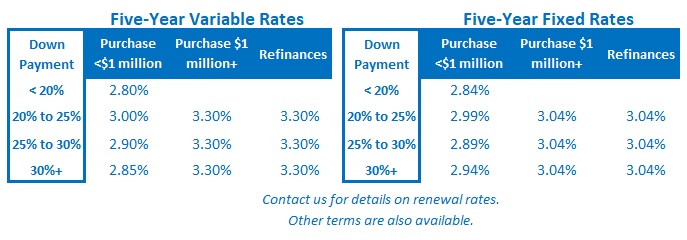How Bank of Canada Governor Poloz Can Help Increase the Appeal of Longer-Term Mortgages
May 13, 2019Why the Bank of Canada and the Bond Market Still Don’t See Eye To Eye
June 3, 2019 The Bank of Canada (BoC) recently reminded us that its primary mandate is to keep inflation “low, stable and predictable”, even if doing so “may create side effects that make the economy vulnerable to new shocks.”
The Bank of Canada (BoC) recently reminded us that its primary mandate is to keep inflation “low, stable and predictable”, even if doing so “may create side effects that make the economy vulnerable to new shocks.”
Given that, anyone keeping an eye on mortgage rates should be paying closing attention to the inflation data, the latest of which were released by Statistics Canada last week.
Here are five highlights:
- Our overall Consumer Price Index (CPI) rose by 2% in April on a year-over-year basis. This is rarified air for our overall CPI, which has languished below the Bank’s 2% target roughly 90% of the time since 2008. While last month’s result marked our fourth straight monthly increase, that didn’t come as a surprise to the BoC, which forecast that our overall CPI would rise to 2.1% by the fourth quarter of this year in its latest Monetary Policy Report (MPR).
- The BoC’s three key sub-measures of inflation all remained near 2% on a year-over-year basis: CPI Trim fell from 2.1% to 2.0%, CPI Median fell from 2.1% to 1.9%, and CPI Common remained flat, at 1.8%. (Check out this post for a detailed definition of each CPI sub-measure.)
- Prices rose in seven of the eight major component categories last month on a year-over-year basis, with the biggest rises occurring in shelter and transportation. Only the household operations, furnishings, and equipment category declined last month.
- Gas prices decreased by 1.6% on a year-over-year basis in April, but that drop was caused by a sharp decline in prices at the end of 2018. Thus far in 2019, gas prices have increased steadily on a month-over-month basis, and they surged higher by another 10% in April on the back of new carbon taxes, which were introduced by the federal government.
- Also of note, the U.S. federal government has just removed the tariffs that it had placed on Canadian steel and aluminium imports, and our federal government responded in kind by lifting the tariffs on U.S. goods that it had enacted in retaliation. This will put downward pressure on a broad swath of Canadian prices going forward.
The latest inflation data are largely in keeping with the BoC’s most recent forecast and are therefore unlikely to cause the Bank to alter its existing monetary-policy plans. That said, weaker-than-expected data in other areas like exports, business investment, manufacturing production, and business sentiment portend slowing economic momentum and reduced inflationary pressures ahead.
The Bottom Line: The April inflation data were largely in line with the BoC’s most recent forecasts, and as such, the Bank should feel no added pressure to raise its policy rate in response. Conversely, the recent weakening in our broader economic data, in combination with the removal of the tariffs associated with the U.S./Canadian trade dispute, give the Bank plenty of latitude to lower its policy rate instead. While the BoC is not yet publicly entertaining this possibility, I continue to believe that its next rate move will most likely be a cut. Stay tuned.








